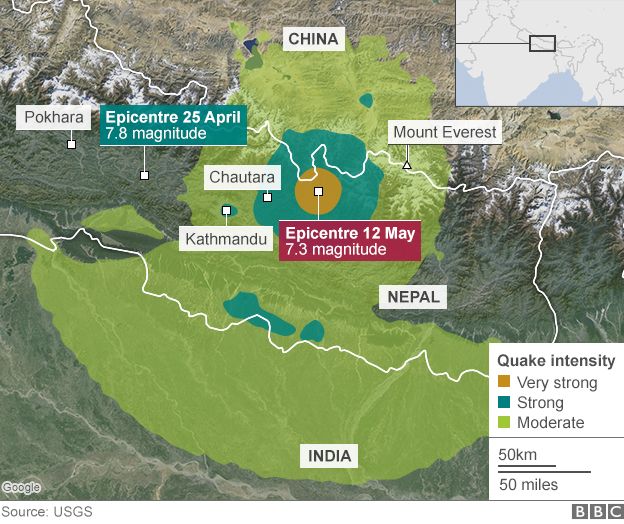Why is Nepal continuing to suffer from earthquakes?
At least 42 people died and more than 1,000 more were injured by the earthquake on May 12. Here is why Nepal continues to be earthquake and what will happen next.
Why does Nepal suffer from earthquakes?
A second major earthquake struck Nepal on May 12 , less than 3 weeks after the country was devastated by an earthquake on April 25, killing more than 8,000 people. According to the US Geological Survey, the May 12 earthquake was 7.3 on the Richter scale, equivalent to the strong earthquakes that occurred in the 1970s. The heart of this earthquake was 50 miles away. east of Kathmandu, near Mount Everest. Even people in some parts of India, Bangladesh and China feel this tremor.

On May 12, another strong earthquake struck Nepal.
At least 42 people died and more than 1,000 more were injured by the earthquake on May 12. Here is why Nepal continues to be earthquake and what will happen next.
What is earthquake aftershock?
Large earthquakes often involve a number of smaller earthquakes that are often referred to as aftershocks.
The aftershock is exactly the same as the earthquake , except that it is lighter than the main earthquake and is related to the main event. The only difference is that aftershocks often occur in the same basic positions, "in aftershock" and often occur before the geological activities return to the same level before the earthquake occurs.
Was the Nepal earthquake on May 12 the aftershock?
Some aftershocks may occur on the near fractures outside the aftershock, but yesterday may be considered a separate earthquake . In contrast to the April earthquake center west of Kathmandu , the earthquake on 12/5 occurred in the east of the capital, near the Chinese border.
Tuesday's earthquake also caused a seismic shock. Only 30 minutes after the 7.3-magnitude earthquake occurred, a 6.3-magnitude aftershock occurred. There have been 5 more aftershocks with intensity of 5.0 or higher.
So the earthquake on April 25 and May 12 was not related to each other?
There is evidence that earthquakes can spark other earthquakes, even outside aftershocks. Nepal is on a continental collision zone between India and Eurasia and changes that occurred after the April earthquake likely triggered the earthquake that hit May 12. In fact, the US Geological Survey (USGS) has predicted a aftershock with the probability that a strong earthquake from 7 to 7.8 on the Richter scale occurred this week.
The earthquake on April 25 caused many aftershocks?
A series of stable aftershocks occurred in Nepal as a result of the earthquake in April, starting from aftershocks that occurred every 15-20 minutes . One day after the earthquake, a shock of 6.7 Richter happened in the same area, causing snowfall on Mount Everest , landslides on highways and some places in northern India also felt trepidation. On May 1, more than 100 aftershocks with a strength of more than 4.0 degrees occurred.
Will more aftershocks occur after yesterday's earthquake?
Yes. In general, the greater the intensity of earthquakes , the greater the number of aftershocks. Any major earthquake always causes aftershocks. These aftershocks can continue for weeks, months and even years. They often decrease in number but it is difficult to tell when they will happen or where.
Will the next aftershock be worse?
Sometimes, aftershocks may be larger than the initial earthquake. In fact, what caused the initial earthquake was due to vibrations that occurred before and in the earthquake area. But the movements, the aftershocks that happened earlier were only detected when the earthquake happened.
- Why do earthquakes in Nepal have great destructive power?
- The intensity of earthquakes in Nepal is equivalent to 20 atomic bombs
- Nepal still shook because of aftershocks, after a month of earthquakes
- Risk of flash flood and landslide in Nepal
- Nepal is about to suffer a Haiti-like earthquake
- Interesting facts about Nepal
- More than 5,000 people died from earthquakes, Nepalese people resented rescue
- 1,000 missing Europeans in Nepal after the earthquake
- The earth 'stirred' under the influence of the earthquake in Nepal
- Video: Snowfall moment buried in Mount Everest camp
- Three Asian countries shook because of the earthquake
- Always chasing women when it comes to menstrual periods in Nepal
 Is the magnetic North Pole shift dangerous to humanity?
Is the magnetic North Pole shift dangerous to humanity? Washington legalizes the recycling of human bodies into fertilizer
Washington legalizes the recycling of human bodies into fertilizer Lightning stone - the mysterious guest
Lightning stone - the mysterious guest Stunned by the mysterious sunset, strange appearance
Stunned by the mysterious sunset, strange appearance